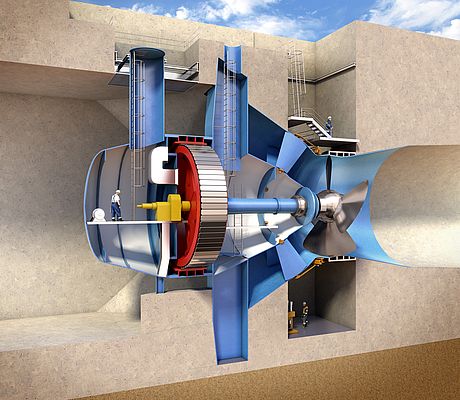Mr. Oram, nowadays renewable energy is a very hot topic for companies operating in energy field. In the framework of GE's solution range dedicated to power generation, can you explain us the role played by renewables, and specifically that of tidal and offshore wind power solutions?
GE Power Conversion provides the technology for converting Mechanical to Electrical, Electrical to Electrical and electrical to mechanical Energy and as such is at the forefront of technology and solutions required for the growth of renewables within the overall power generation mix. This includes providing Inverters to convert DC electrical power to AC electrical power for grid connection of large Solar farms, or the conversion of tidal or wind (mechanical) energy to electrical energy through Induction or PMG generators which are then interfaced to the grid through variable speed drives providing the required grid code compliance. GE further supplements this core technology with the balance of plant (switchgear, transformers and distribution), needed to connect the tidal or offshore wind turbines to the grid on shore this includes the supply of Statcom, SVC required to stabilize the grid. The growth of renewables in the overall energy mix over the past 10 years has seen significant development in onshore wind and large-scale solar PV plants, however as available sites for these types of renewables reduce, the obvious solution is to look offshore whether it be above the surface of the oceans to capturing the excellent offshore wind resource or below the surface to extract energy from the abundant and predictable tidal power. These new 'marine' renewables sources will drive the next growth in renewables on a global scale. GE has an extensive experience in providing equipment into the marine environment whether it be onboard or offshore O&G platform, Cruise Ship, LNG Tanker or state of the art Naval vessel, the experience gained will be invaluable to ensure that the solutions for tidal and offshore wind are highly efficient, reliable and cost effective. The capability of GE Marine also extends to providing Dynamic Positioning and electric power & propulsion systems for support vessels, specifically designed for the deployment of offshore wind/tidal turbines and their repair/maintenance.
In your recent intervention Fishing for Energy Efficiency under and over the sea you consider the ocean as "a key future energy resource". Is ocean the natural resource with the greatest unexploited power generation potential? Do you expect it to be the most promising resource for a green and efficient energy future?
There is the potential to develop 20 000‑80 000 TWh of electricity generated by changes in ocean temperatures, salt content, movement of tides, currents, waves and swells. (IEA) But as of today, ocean remains an untapped resources - if less than 0.1% of the energy available in the oceans could be captured and converted into electricity, it would satisfy the present global demand for energy more than five times over (source: UK Marine Foresight Panel). The Marine Renewables industry has learnt a lot from the developments in wind, and aims to secure itself as a profitable and attractive Renewables alternative, in an accelerated period of time. With the technology already developed, the industry now has to turn itself into the new poster child of green energy. Taking Swansea Bay Tidal Lagoon as an example: it is the first time we apply mature hydro technology (which remains the most significant portion in today's renewable energy mix) to the ocean energy. I firmly believe it will unlock the huge potential of power from the ocean and support our future energy demand.
To what extent can we consider tidal energy a reliable source of power? Its efficiency rates might be higher than solar and wind, given that tides seems to show a higher predictability?
The unpredictability associated with solar and wind power generation, primarily caused by unanticipated weather conditions, poses a challenge to grid stability. However, rise and fall of the tides are cyclic and completely predictable even years in advance, enabling more efficient planning around base load and peak power requirements across the grid, and ultimately reducing the overall cost of integrating Renewables into the grid. Moreover, we can take the advantage of time shifts between tides at different locations. For example, the tides in South Wales and West Cumbria in the UK have about 5 hours time difference, allowing future tidal farms to generate electricity at different times of a day. The latest tidal project Swansea Bay Tidal Lagoon is living evidence as tidal energy could become a reliable and affordable source of energy to provide electricity on a utility scale. It is expected to provide power for over 155,000 homes (equivalent to 90% of Swansea Bay's annual domestic electricity use) and is expected to have an operational life expectancy of 120 years.
There is a project for building a tidal lagoon in Swansea Bay, Wales, which is expected to provide up to 8% of British power needs by 2027. Is there any efficiency rate gap between power harnessed in a tidal lagoon and power harnessed offshore? Can you tell us which role will be played by GE in this project?
At Swansea Bay, GE is involved in both power generation and transmission of power to the shore. GE will provide large induction generators and state-of-the-art Variable Speed Drives (VSD) based on its medium voltage drive technology. The equipment is well proven across multiple industrial and renewable energy applications such as onshore/offshore wind, mining, oil & gas and marine. It builds upon the previous experience with the UK Navy, where it has been successfully deployed in numerous vessels over the past 10 years. The strengthened capability of induction generators and VSD technology helps maximize energy production and reliability in this new tidal energy generation application. GE's partner Andritz Hydro will provide hydro turbine technology for the project. GE and Andritz Hydro together will also be responsible for ensuring that the power connected to the National Grid complies with the latest grid codes. The efficiency rate transforms depending on the project and technologies adopted. For example, Swansea Bay is expected to deliver 93% efficiency on the ebb tide and 81% efficiency on the flood tide.
In the current economic scenario, especially in the EU zone, is renewable energy market a concrete factor of growth and development for companies? Are European policies and regulations effectively supporting renewable energy business?
The Renewable Energy Directive sets rules for the EU to achieve its 20% renewables target by 2020. The EU adopted guidance for EU countries clearly suggests support schemes should be respond to falling production costs. As regarding to tidal energy - In Europe, the industry has now got to the point where tidal power is well advanced in terms of the designs of the turbines. The top companies in the business have all developed full scale designs, tested them in open seas or in test centers and have generated electricity. The next stage is starting now, with pre-commercial tidal arrays, where real working projects have secured consortium partners, carried out due diligence and established financial support. The supply chain will reduce its cost, technologies will be more proven, and more investors will get attracted. There are needs to remain a focus on continuing support both at EU and individual member states Government level to support the renewable energy business to reduce costs, this needs to be heavily focused on driving cost out of existing solutions as well as investing in R&D to develop future technologies to increase efficiency or reduce cost.
How do you imagine the future of power supplying? Will we see more and more adoption of renewables and will the Internet of Things be the IT turning point allowing us to manage energy and data in a revolutionary way?
Future of power supplying will rely more and more on renewable energy. The role of renewable sources in the global power mix continues to increase rapidly. As global renewable electricity generation expands in absolute terms, it is expected to surpass that from natural gas and double that from nuclear power by 2016, becoming the second most important global electricity source, after coal. Globally, renewable generation is estimated to rise to 25% of gross power generation in 2018. (Source: IEA) The Industrial Internet-the combination of Big Data analytics with the Internet of Things - is producing huge opportunities for companies in all industries, enabling machines / equipment to operate longer and produce more power by increasing up time through predictive rather than reactive maintenance and optimizing controls to improve efficiency and or operating range/capability. For example, strong data analytics capabilities, according to GE's estimates, will allow wind farm operators to raise output by up to an additional 5 per cent through the optimization of performance based on environmental conditions.
























































